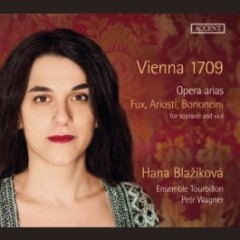Vienna 1709: Opera Arias - Fux, Ariosti, Bononcini (2014)
Vienna 1709: Opera Arias - Fux, Ariosti, Bononcini (2014)

Pietro BALDASSARI (before 1672 -after 1747) 1.Il giudizio di Paride: Il Goder un bel sembiante (1707) [5:30] Attilio ARIOSTI (1666-1726) 2.Marte placato: Sa il crudel (1727) [5:22] 3.Marte placato: Sinfonia (1727) [2:56] 4.La Placidia: Tal vicina a Giglio (1709) [3:18] 5.La profezie d’Eliseo: Prole tenera (1705) [5:35] Giovanni Battista BONONCINI (1670-1747) 6.Il ritorno di Giulio Cesare: E pur le mie rovine (1704) [4:46] 7.Il fiore delle eroine: Amante ozioso (1704) [4:02] Johann Joseph FUX (c. 1660-1741) 8.La decima fatica d’Ercole: Sento nel core (1710) [7:45] 9.Il Fonte della Salute aperto: So’che piace (1716) [7:15] 10.Il mese di Marzo: Non sdegnar (1709) [5:11] 11.Dafne un Lauro: Lascio d’esser Ninfa [5:33] Hana Blažíková [soprano] Ensemble Tourbillon Petr Wagner [direction]
The young Czech soprano Hana Blažíkóva is one of the most exciting voices in the baroque scene. Conductors such as Philippe Herreweghe, Masaaki Suzuki and Vaclav Luks frequently invite her for CD recordings, concerts and tours. She regularly appears at renowned festivals including Prague Spring, Festival Oude Muziek Utrecht, Resonances in Vienna and the Early Music Days in Regensburg.
The title 'Vienna 1709' is representative of those arias from operas and oratorios that were composed during the first two decades of the 18th century in Vienna especially for the birthday or namedays of members of the imperial family. This selection presents arias of Fux, Ariosti and Bononcini in which the solo voice enters into a dialogue with one of several violas da gamba. Ensemble Tourbillon, under the direction of the Prague gambist Petr Wagner, supports Hana Blažíkóva and her clear, angelic soprano voice - capable of both virtuosity and delicate sensitivity. --- ukstore.harmoniamundi.com
Czech soprano Hana Blažíková is an increasingly valued performer of older music, and I’ve admired her singing for several years. Here she joins compatriots from Ensemble Tourbillon, directed by viol player Petr Wagner, who play on copies patterned after a variety of original instruments – many French, but examples are here by modern makers patterned after Italian, German and English originals. There is one exception to this rule: Wagner employs both a 2012 Claus Derenbach viol, patterned after a Romain Cheron of 1685 but he also plays on an original 1697 instrument made by Tielke in Hamburg. I stress this because the disc title, ‘Vienna 1709’, references the fact that these operatic arias, mostly little-known, are notable for their viol accompaniment. This is certainly true up to a point, but the arias by Fux, Ariosti, and Bononcini also contain a second viol accompaniment as well as, variously, harpsichord, theorbo, baroque guitar, baroque oboe and chalumeau.
Vienna’s power and prestige was such that the city could afford to employ a distinguished raft of composers and instrumentalists in the early eighteenth century, and many were Italian. The Emperors of the time frequently played the viola da gamba, and the court was awash with musicians. Though not all the music was composed precisely in the year 1709 it serves as a conveniently precise date for a recital that embraces the years 1704 to around 1716. Baldassari’s Il Goder un bel sembiante sees the viola da gamba employed for its expressive commentary to Blažíková’s pure, focused soprano. It sets the pattern for the rest of the disc where the viol takes either an obbligato or a more central role in the arias. Paired viols add a different richer texture and feature prominently in the recital though as the music comes from a variety of sources – serenata, oratorio pastoral opera – the function of the viol accompaniment is subtly different. It’s as well to note here that the disc title, which proclaims these to be opera arias, is immediately contradicted by the music which, as noted, derives from a wider variety than the merely operatic. It has the advantage, however, for the record collector, of being rare.
Whilst Fux may be the best-known of the quartet now, Bononcini was then an eminent presence in European music-making of his time. The music reflects his standing, and is wide-ranging in its demands, technical and expressive. Fux is also represented by a later work, So’che piace from the oratorio Il Fonte della Salute aperto, a fine example of his more quietly reflective, even ascetic late style. Non sdegnar is also modest and fluent. The Chalumeau provides obbligato here, the music being an ingenious Austro-Italian compound, though never veering to the showy. There is an Ariosti Sinfonia, all instrumental, with two piping oboes to the fore. It shows the timbral variety to be heard in a disc that could be seen to hide its light under a bushel in focusing on merely the viol contribution.
The booklet is helpful but a bit skewed in favour of the viol-only concept, if I can phrase it that way. The church acoustic is pretty good, catching the instrumental and vocal strands without fuzziness.
The instrumental playing is on a high level and Hana Blažiková sings with precision and focus. Petr Wagner, solo viol player, directs with a sure hand for texture and tempo. Much here is very rare on disc, an added incentive for specialists. ---Jonathan Woolf, musicweb-international.com
download (mp3 @320 kbs):
yandex 4shared mega mediafire cloudmailru uplea ge.tt








